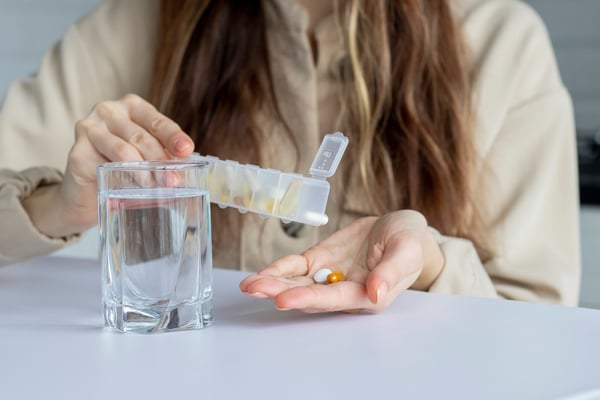How Clinical Pharmacists Can Boost Medication Adherence Rates

More than 131 million adults in the United States, a whopping 66% of Americans, take prescription medication. Even though so many are prescribed medication deemed necessary by their physician(s), don’t take them as prescribed. As a result, our healthcare system has a $300 billion problem – medication nonadherence.
Nonadherence describes the phenomenon of patients either not taking their medications at all or, more commonly, not taking them properly. It's not difficult to imagine the downstream negative effects of nonadherence, but fortunately, pharmacists are equipped to improve adherence, patient health, and the management of chronic conditions.
While the damage to the patient’s health is evident, the cost to health plans often goes unseen. In fact, failure to take prescribed medications is responsible for 16% or $500 billion in healthcare spending each year, as those patients often need additional or emergency care or hospitalization. With the 5-Star rating system introduced by the Affordable Care Act, it’s never been more critical for health plans to modernize their medication adherence programs for both the health of their members, and their bottom line.
The traditional role of clinical pharmacists
The standard view of the role of a clinical pharmacist, especially for those not as intimately familiar, is simply as a medication expert who oversees the accurate and effective dispensing of medication. This narrow view minimizes the role a clinical pharmacist can and should have in patient care and patient outcomes. While clinical pharmacists are tasked with dispensing prescriptions and medications, their role also includes advising and consulting with the primary care team on using pharmaceuticals in patient treatment; creating and developing drug care plans to complement other modalities; and managing, preparing, and dispensing medication. In short, the clinical pharmacist is a vital member of a patient’s care team when it comes to the role of medications in both acute and long-term care. When included in patient care teams and planning, research suggests the inclusion of a clinical pharmacist increases positive health outcomes.
The challenges of medication adherence
Intense focus has been placed on medication adherence over the last few years, and with good reason. The impact of nonadherence is significant – creating dangerous situations for patients and costing the healthcare system billions of dollars every year. However, part of the larger problem requires understanding the challenges faced by patients and care teams when ensuring adherence to prescribed medications. While frustrating, medication non-adherence often runs deeper than just resistance to a treatment plan. Patients may be nonadherent due to transportation difficulties in getting to the pharmacy, a lack of understanding of proper medication administration, or misunderstanding their medication and its uses. In one study, the average nonadherence rate across all diseases is roughly 25%, according to a meta-analysis of more than 500 studies. However, certain medications were more frequently associated with nonadherence than others. Nonadherence is highest in patients with arthritis, gastrointestinal disorders, and, most surprisingly, cancer. These illnesses and conditions pose significant threats to life and quality of life, suggesting we need a much better understanding of why patients make those choices. Some frequent challenges to medication adherence include:
- Poor communication between the treatment team and patient
- Access to or cost of medications
- Poorly educated patients/lack of information about treatment or condition
- Lack of acknowledgment of the impact of non-adherence to medication on negative outcomes/death
- Stigmas/fears related to specific medications
- Comorbidities that impact adherence to medication regimens
- Lack of trust between patient and provider
- Patient denial over the seriousness of an illness/condition
However, for many, fear of adverse side effects is the number one reason to avoid taking a prescribed medication. In a poll conducted by Health Dialog, people were asked to say which side effects would make them stop taking their medications. These are the results:
- 38% sudden weight gain
- 34% feeling of nausea
- 19% fatigue and dizziness
- 9% visible skin irritations
At the surface level, some might chalk up nonadherence to these simple fears. Often though, nonadherence is a compound issue. For example, fear and misunderstanding are symptoms. The larger problem is the lack of proactive education, intervention, and a dedicated medication adherence program resource. Medication adherence, as a clinical goal, must factor in each of the potential challenges as we seek out more effective ways to ensure patients are able to not only access medications but to take them in the prescribed dosage at the right times.

Why medication adherence is important
A lack of proper adherence can hinder one’s ability to treat serious diseases. That, of course, leads to more medical complications down the line and lower life quality for the patient. The negative impact isn’t only on the patient. For health plans, lack of adherence leads to increased healthcare costs and poorer health outcomes – which ultimately leads to a dip in quality scores (HEDIS/Stars). Of the 40 key quality measures in the Medicare Stars rating system, 12 are prescription drug specific. In addition, these factors have a weighting of 1x to 5x, making them a vital component for the overall plan rating. With Star Ratings bonus payments expected to exceed $2 billion for the large, public Managed Care Organizations (MCOs) in 2015 alone, adherence should be a top priority for MCOs. Let’s dive deeper into the impact on both patients and health plans.
Nonadherence impact on health
A patient’s inability to obtain and use medication appropriately limits the drug’s effectiveness. Nonadherence can lead to many unwanted side effects. One study discovered that seniors taking statin-reducing medications could increase the risk of dying of a heart attack by 25% if they suddenly quit them.
Nonadherence plays an especially harmful role when it comes to specialty medication management. Patients prescribed specialty medications are often some of the sickest, and missing doses or improper dosing could be the difference between well-managed chronic conditions and a trip to the emergency room. Specialty medications are also often very costly, so it’s in the best interest both of patients and of their health plans that they maintain proper medication adherence.
Non-adherence impact on mortality
Each year, more than 125,000 preventable deaths occur in the US due to medication nonadherence. These deaths could be easily avoided if healthcare professionals explained to the patients that dying from nonadherence to medication is ten times greater than dying from homicide. It's a tragic thought that nonadherence is responsible for such a large loss of life in the US every year. But the good news is that new technologies and care delivery models such as Aspen RxHealth are paving the way toward prevention.
Non-adherence healthcare system costs
As people age, unsurprisingly, the cost of medically managing their conditions grows. Financial experts estimate that between $100 and $300 billion in annual healthcare costs are easily avoidable. To put this into perspective, consider that these costs represent between 3% and 10% of the US total healthcare costs annually. By improving adherence to medication regimens, we can substantially improve the health of our nation, and subsequently, lower healthcare costs for all of us.
How clinical pharmacists impact medication adherence
Providing patients with enough information, keeping a blame-free environment, and delivering positive feedback for medication adherence are critical to a trusting provider-patient relationship. Because health is a very personal topic, addressing the issue of medication adherence needs to take a more personal approach. This is a role clinical pharmacists can step into quite easily for a variety of reasons. Understanding the scope of the problem and why so many people fail to follow simple instructions are essential first steps in solving this problem. The final step in preventing non-adherence is creating a system of accountability for the patient. And in many cases, this begins with the simple step of creating scheduled, pharmacist-led clinical consultations. For example, assessing medication-taking can be done through self-reporting. Studies show that some patients overestimate adherence by a staggering 200%. Simply by talking to the patient at scheduled intervals, one can learn a lot about their habits. These 1-to-1 long-term relationships enable pharmacists to understand which patients are at higher risk for non-adherence and employ tactics to limit lapses. Further, this regular contact and relationship-building increase trust and improve the likelihood of patients attending scheduled meetings with their providers. Before anything, the patient needs to show up in order for a provider to educate them on what the medication does, how it helps them, and how much it improves the quality of their life. Here are a few strategies used by the Reliant Medical Group from Massachusetts to improve patient adherence to blood pressure medicine:
- Trying to help patients improve their health literacy on hypertension
- Pharmacist-led calls with patients about medication timing and dosing
- Giving their patients lower-cost, generic medication substitutions
- Pharmacist-led medication reconciliation and monitoring of medication treatment plan
One study found that patients with chronic diseases enrolled in an appointment-based medication synchronization program were 3.4 to 6.1 times more likely to be adherent than patients without synchronized medication refills. Note the critical role clinical pharmacists play in improving patient care, outcomes, and medication adherence.

The Aspen RxHealth difference: patient-pharmacist relationships and medication adherence. While we’ve noted several challenges above, the most significant adherence barriers are frequently created when the relationship between patient and provider is seen as purely clinical or, worse, transactional. An effective medication therapy management (MTM) program that utilizes clinical pharmacists can dramatically improve adherence and patient health through regimented chronic condition management, eliminate the fear of medication-related side effects through education, proactively identify medication adherence gaps, and drive appropriate interventions.
However, there’s a difference between a qualified provider and the right provider. While there are a multitude of qualified providers out there, for many patients, the “right provider” means one matching patients to clinical pharmacists based on criteria like native language, geography, specialty, etc. These connections are essential, and research suggests that patients prefer providers who share demographics with them. Patient demographics play a massive yet often underappreciated role in patient health outcomes. For example, a low-income patient located in a rural setting could face diminished outcomes due to their inability to pay for medications or get transportation to their doctor’s office or pharmacy. That’s why at Aspen RxHealth, we match patients to pharmacists based on a wide variety of factors. It allows us to break down barriers that may have previously been keeping patients from the health they deserve. In the example of a rural, low-income patient, an Aspen RxHealth pharmacist in a nearby location can empathize with their transportation difficulties, speak to them in the way they feel most comfortable, and even recommend local programs to assist with medication costs.
Research also suggests that patient outcomes are improved and incidents of implicit bias decrease when adherence improves. In fact, in one study that focused on collecting large amounts of data on patient behavior, clinicians at Sichuan Provincial People’s Hospital successfully evaluated peoples’ adherence status.
By recording demographics, disease, treatment, diet, exercise, and mental status information, researchers found that 21.2% of the patients were susceptible to poor adherence. While making this connection might seem overwhelming, healthcare technology companies, like Aspen RxHealth, already specialize in this sort of matchmaking. Nonadherence is one of the enormous costs and fatality drivers in healthcare today, but it also represents one of the biggest opportunities. Matching patients with the right provider is one of those opportunities.
Patient education is another key area in which clinical pharmacists can positively impact medication adherence. In many cases, a lack of adherence is caused by a lack of patient understanding of their medications, how they work, and why it’s important to take them as directed. This is especially important in patients suffering from chronic conditions. Through regular patient interactions, remote pharmacists can monitor each patient’s adherence and educate on conditions and any patient concerns. Through this educational, empathetic relationship, clinical pharmacists equip their patients with the tools they need to take an active role in their own health, setting them up for long-term success.
Medication adherence creates healthy, satisfied patients
Beyond the health improvements associated with better medication adherence, patient satisfaction is also boosted. When patients see measurable improvements in their health and the way they feel after a consultation with a clinical pharmacist, they are more satisfied with the care they receive and more likely to remain adherent in the future. While this is a great outcome for patients themselves, it’s also beneficial to their health plans. Satisfied patients have a greater propensity to remain enrolled in their health plan year after year, because they feel valued and appreciate the care they receive to improve their health. It’s easy to see—not only should health plans focus on adherence to improve health, but it’s also smart business.
Through healthcare technology and accessibility to high-quality clinical pharmacists, the quality of resources available to implement effective medication adherence programs has never been higher. And that’s great news for patients and health plans alike. Not to mention the countless remote pharmacists who are now able to do fulfilling work from the comfort of their own home.
If you’ve struggled with medication adherence in any of your populations, we’re ready to give you the support you need.